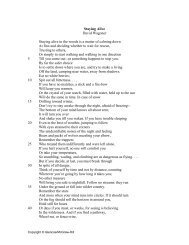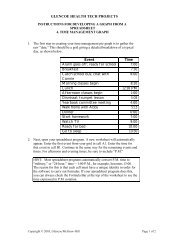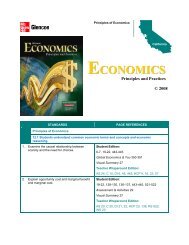Math Handbook - Glencoe
Math Handbook - Glencoe
Math Handbook - Glencoe
Create successful ePaper yourself
Turn your PDF publications into a flip-book with our unique Google optimized e-Paper software.
APPENDIX B<br />
<strong>Math</strong> <strong>Handbook</strong><br />
2. Multiplication and division<br />
When multiplying fractions, the numerators and denominators are multiplied<br />
together as follows:<br />
1 2 2 3 1 <br />
<br />
2<br />
3 2 3 6 1 3 <br />
Note the final answer is simplified by dividing the numerator and denominator<br />
by two.<br />
When dividing fractions, the divisor is inverted and multiplied by the<br />
dividend as follows:<br />
2 3 1 2 2 3 2 1 2 <br />
<br />
2<br />
4 3 1 3 <br />
<strong>Math</strong> <strong>Handbook</strong><br />
Figure 22<br />
Carbon-dating of this skull is<br />
based on the radioactive decay<br />
of carbon-14 atoms which is<br />
measured in half-lives.<br />
Table 4<br />
Comparison Between<br />
Exponents and Logs<br />
Exponent Logarithm<br />
10 0 1 log 1 0<br />
10 1 10 log 10 1<br />
10 2 100 log 100 2<br />
10 1 0.1 log 0.1 1<br />
10 2 0.01 log 0.01 2<br />
PRACTICE PROBLEMS<br />
20. Perform the indicated operation:<br />
a. 2 3 3 4 e. 1 3 3 4 <br />
b. 4 5 3<br />
<br />
10<br />
f. 3 5 2 7 <br />
c. 1 4 1 6 g. 5 8 1 4 <br />
d. 7 8 5 6 h. 4 9 3 8 <br />
Logarithms and Antilogarithms<br />
When you perform calculations, such as using half-life of carbon to determine<br />
the age of the skull in Figure 22 or the pH of the products in Figure<br />
23, you may need to use the log or antilog function on your calculator. A logarithm<br />
(log) is the power or exponent to which a number, called a base, must<br />
be raised in order to obtain a given positive number. This textbook uses common<br />
logarithms based on a base of 10. Therefore, the common log of any<br />
number is the power to which ten is raised to equal that number. Examine<br />
Table 4. Note the log of each number is the power of ten for the exponent of<br />
that number. For example, the common log of 100 is two and the common<br />
log of 0.01 is 2.<br />
log 10 2 2<br />
log 10 2 2<br />
A common log can be written in the following general form.<br />
If 10 n y, then log y n.<br />
In each example in Table 4, the log can be determined by inspection. How<br />
do you express the common log of 5.34 10 5 ? Because logarithms are exponents,<br />
they have the same properties as exponents. See Table 5.<br />
log 5.34 10 5 log 5.34 log 10 5<br />
910 Chemistry: Matter and Change
















